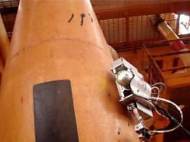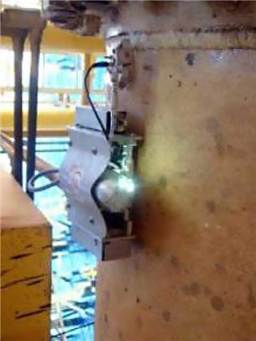RoboPipe built to inspect petrochemical platforms pipes
 Currently, the process pipes that are at a height of more than two meters in offshore or onshore platforms must be inspected by human staff that climbs through scaffolding. In order to lower the risk, Mexican Corporation of Material Research (COMIMSA) designed RoboPipe – a robot prototype able to detect cracks or corrosion inside the pipes in the chemical and petrochemical industry.
Currently, the process pipes that are at a height of more than two meters in offshore or onshore platforms must be inspected by human staff that climbs through scaffolding. In order to lower the risk, Mexican Corporation of Material Research (COMIMSA) designed RoboPipe – a robot prototype able to detect cracks or corrosion inside the pipes in the chemical and petrochemical industry.
Scaffolding approach allowed inspectors to check between four and six meters of a pipe per day, but the RoboPipe tested at Pemex offshore facilities managed to inspect between twelve and twenty meters of pipe per day.
“In COMIMSA we decided to design a very small robot so it could pass between two pipes, through a space of 88 millimeters; also, it had to have the grip to climb up a vertical pipe passing welded joints and not fall because of its own weight or the weight of the equipment it carries to transmit the signals”, said Jesús García Ortiz, Technology Application Manager at COMIMSA.
In cooperation with the Institute of Superior Studies of Monterrey (ITESM), Campus Saltillo, whose mechatronics staff came up with the robot’s hardware, COMIMSA designed a remote controlled robot with a camera and sensors. The camera RoboPipe carries operates under humid conditions, has high resolution which allows it to provide enough details via photos and video.
RoboPipe performs corrosion inspection with ultrasound in order to locate and measure the inner pipe damage. Use of ultrasound technology allows it to measure the thickness of the pipe and pinpointing variations which occur due to damage. After detecting damage, the camera is used to visually verify external corrosion.
The robot can reach inaccessible areas of offshore platforms, up to a height of eight meters. It climbs with the help of magnets and it can overcome obstacles and turn on 90 degree elbows, while the floor personnel monitor data.
Aside being used by chemical and petrochemical industry, RoboPipe could also find applications in inaccessible areas such as buildings and bridges, storage tanks and pressure vessels that got ferromagnetic components the robot could cling to.
COMIMSA is improving the prototype and is developing robots adjusted to serve on offshore platforms and onshore facilities. Once both prototypes are validated, this product will be commercialized with licensing or sale options. They also plan to add a laser system that allows in depth measurement of superficial discontinuities on the outside of the pipes.










Leave your response!